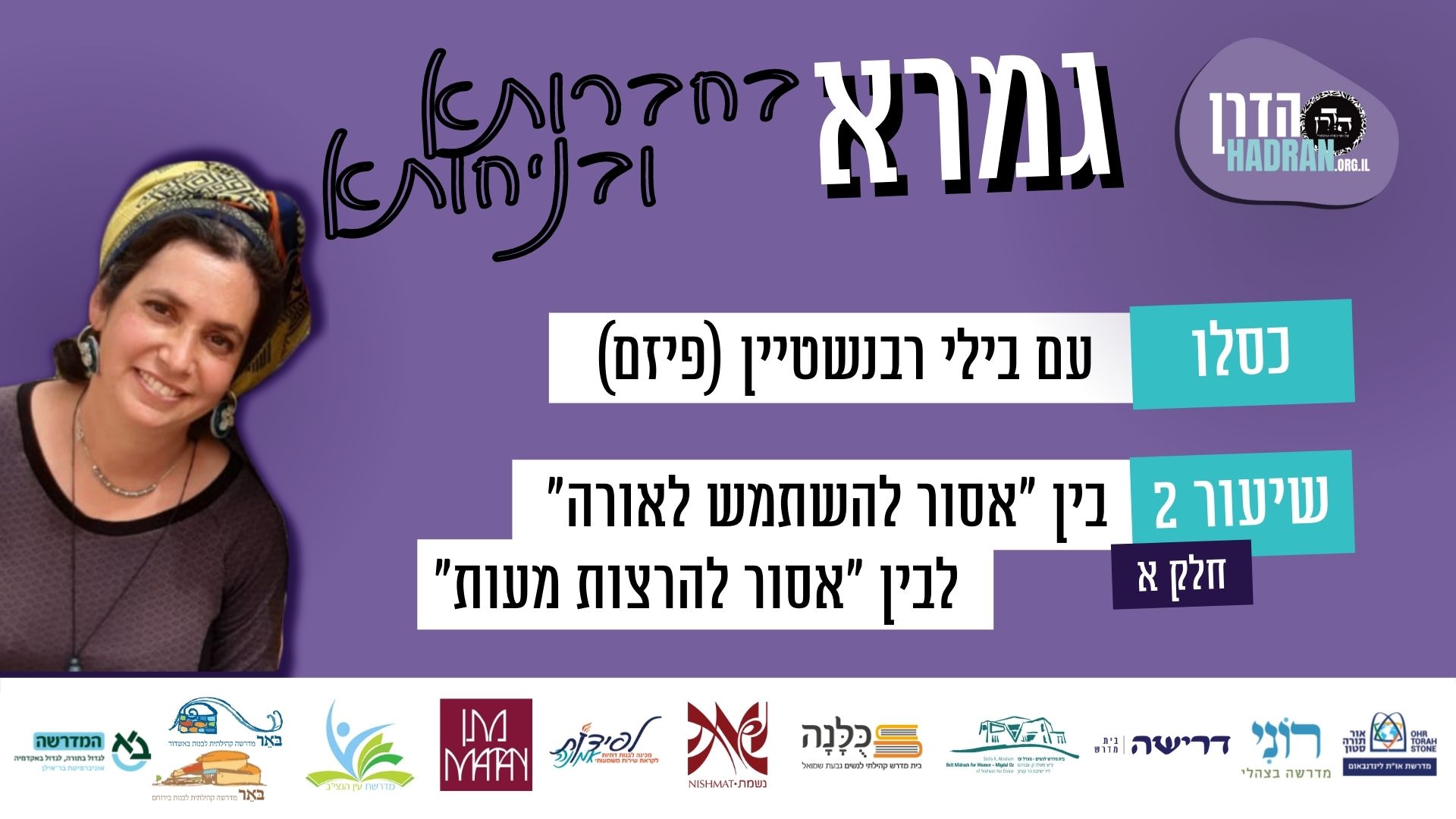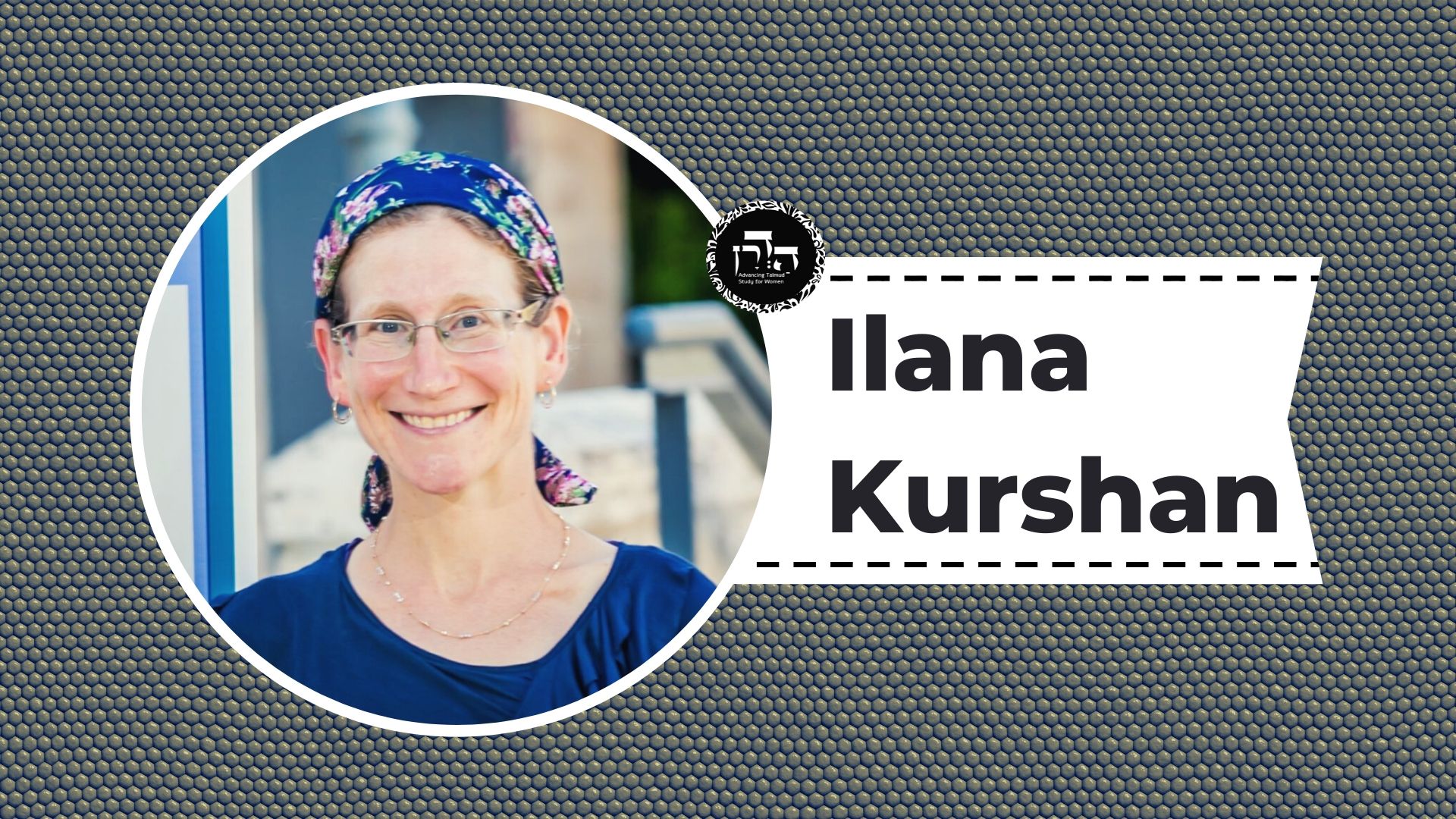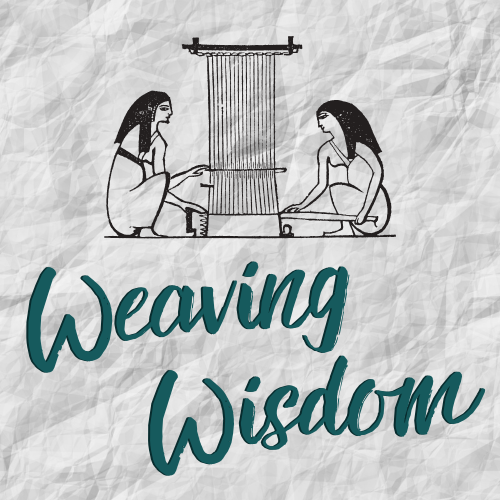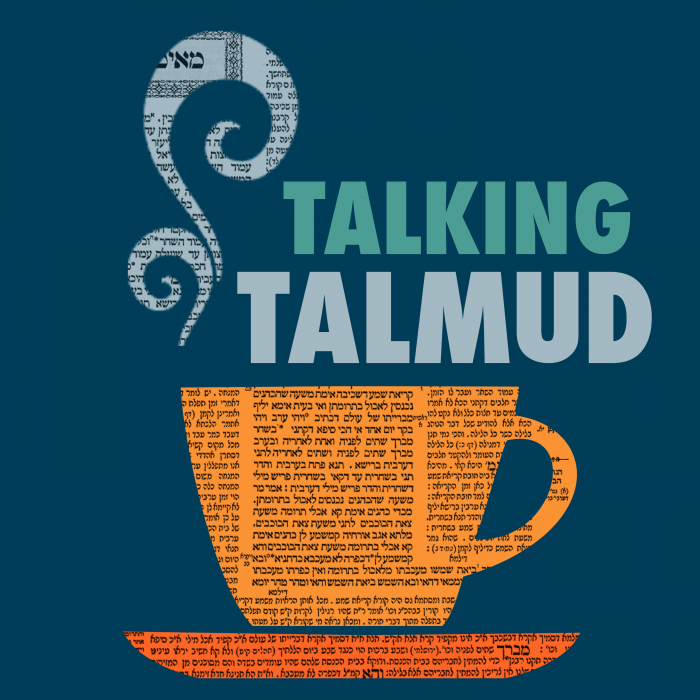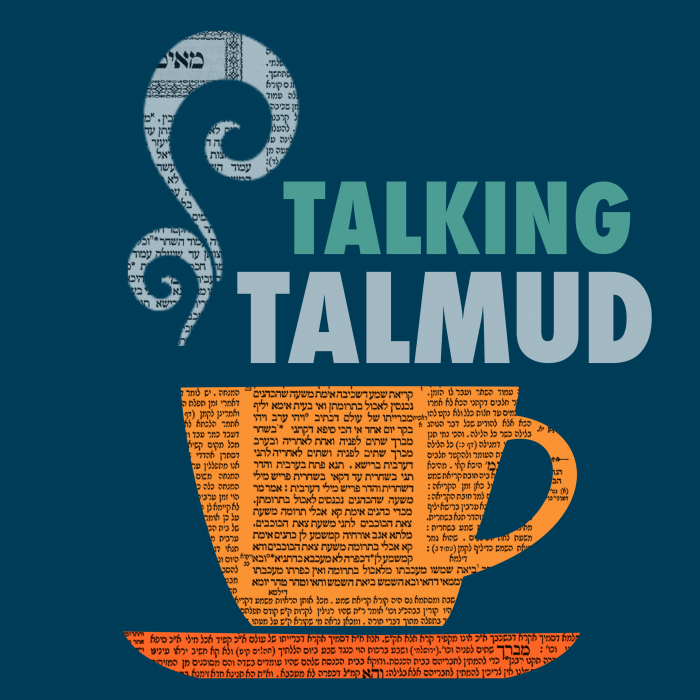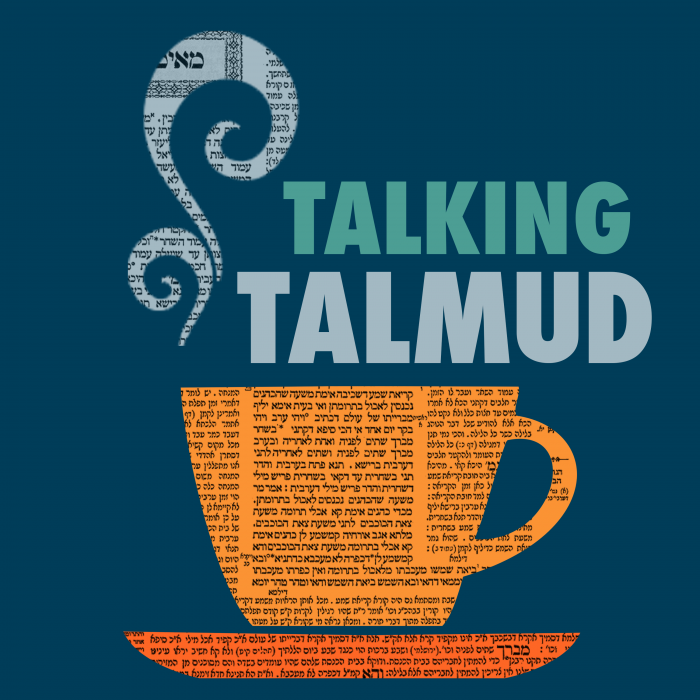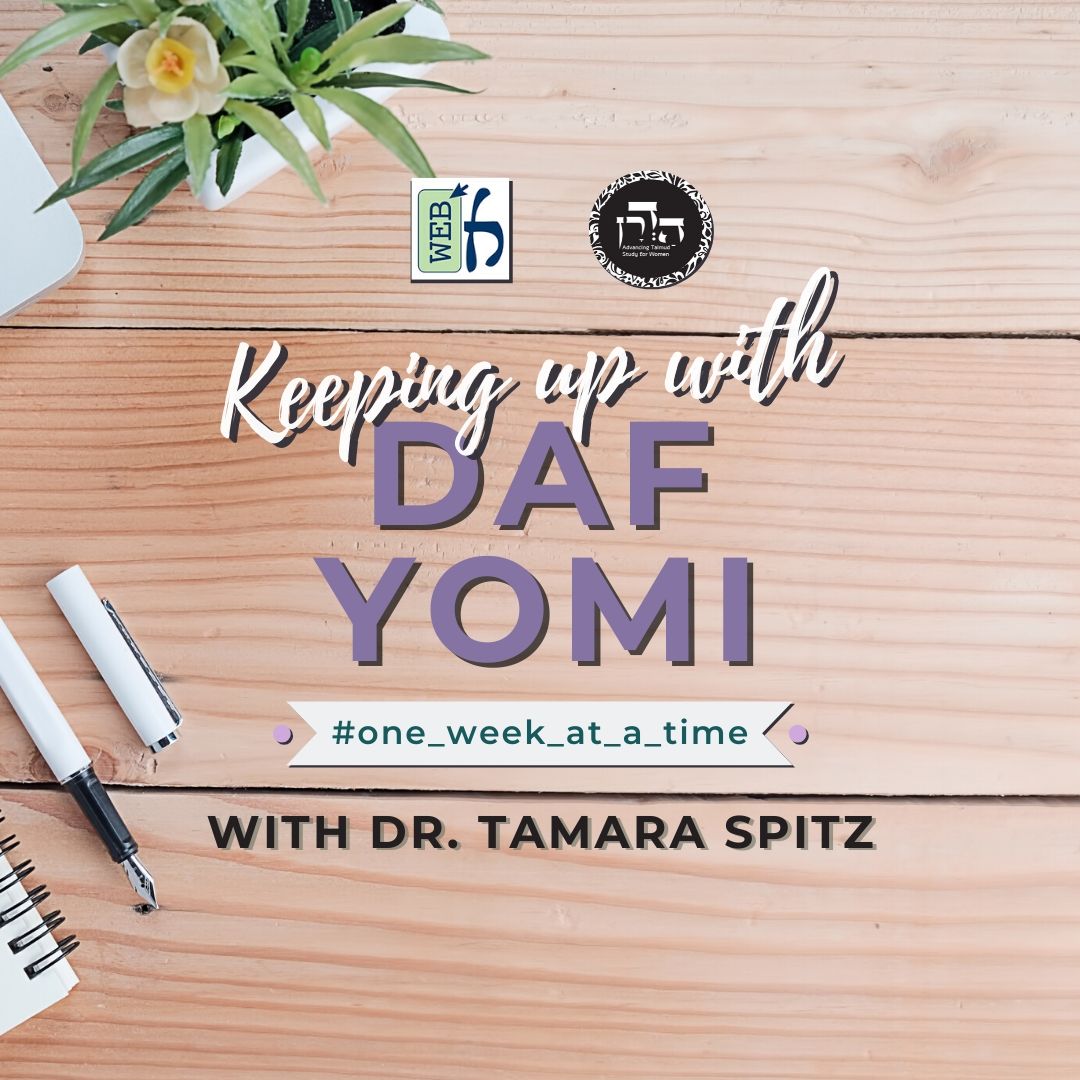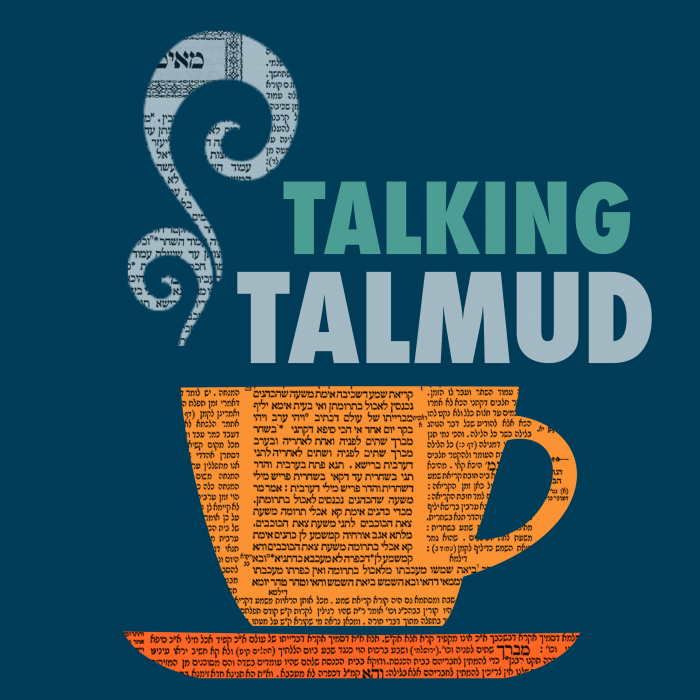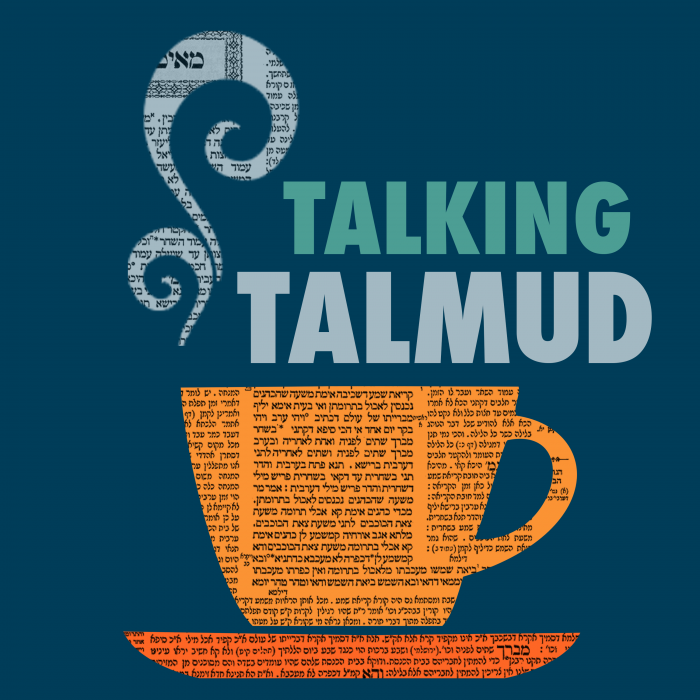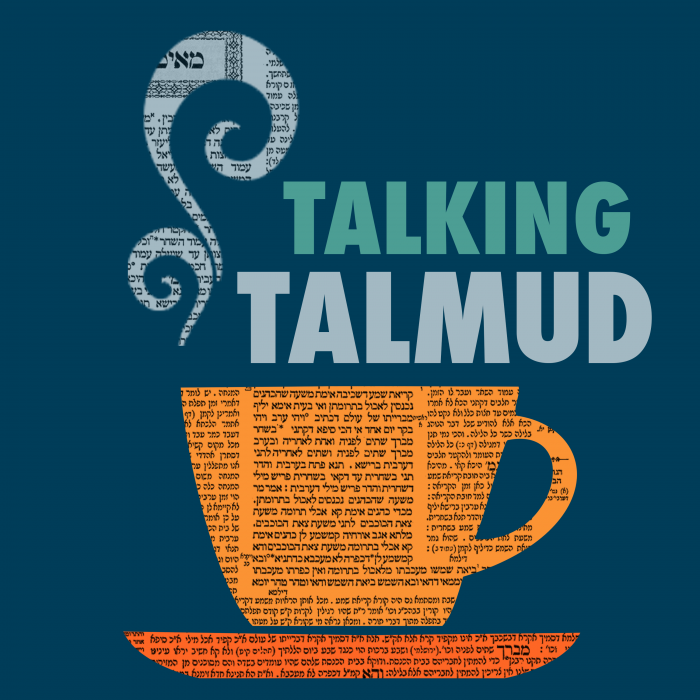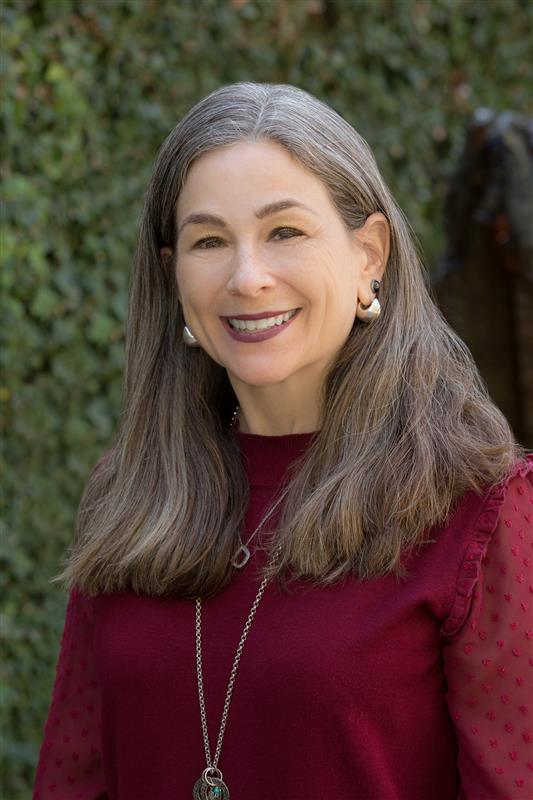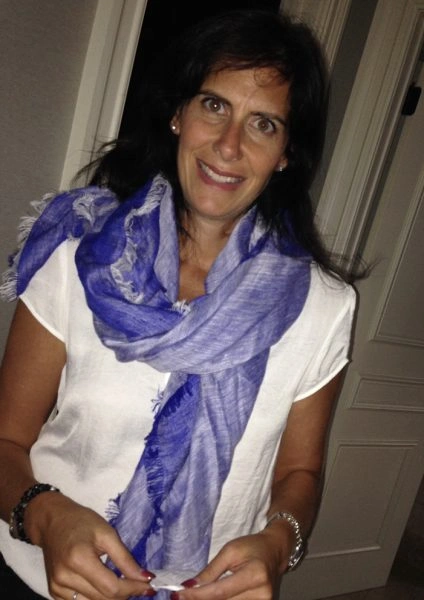Shabbat 142
מַאי אִירְיָא אֶבֶן, אֲפִילּוּ דִּינָר נָמֵי! אַלְּמָה אָמַר רָבָא: לֹא שָׁנוּ אֶלָּא אֶבֶן, אֲבָל דִּינָר — אָסוּר! אֶבֶן, אִי נָפְלָה (לַהּ) — לָא אָתֵי אֲבוּהּ לְאֵיתוֹיֵי. דִּינָר, אִי נָפֵיל — אָתֵי אֲבוּהּ לְאֵתוֹיֵי.
why does the mishna refer specifically to moving a stone? The same should hold true even for a dinar, as well. Why, then, did Rava say: They only taught this in a case where the child has a stone in his hand; however, if the child has a dinar in his hand, it is prohibited to lift the child? The Gemara answers: Actually, lifting the child with a dinar should also be permitted. However, the Sages issued a decree prohibiting lifting the child with a dinar because with regard to a stone, if it falls, his father will not come to bring it. However, with regard to a dinar, if it falls, his father will come to bring it.
תַּנְיָא כְּווֹתֵיהּ דְּרָבָא: הַמּוֹצִיא כֵּלָיו מְקוּפָּלִים וּמוּנָּחִים עַל כְּתֵפוֹ, וְסַנְדָּלָיו וְטַבְּעוֹתָיו בְּיָדוֹ — חַיָּיב. וְאִם הָיָה מְלוּבָּשׁ בָּהֶן — פָּטוּר.
It was taught in a baraita in accordance with the opinion of Rava: On Shabbat, one who carries out his clothes to the public domain while they are folded and placed on his shoulder, and his sandals on his feet and his rings in his hand, not on his fingers, is liable. And if he was wearing them, he is exempt for all of them, as they are negated relative to him.
הַמּוֹצִיא אָדָם וְכֵלָיו עָלָיו, וְסַנְדָּלָיו בְּרַגְלָיו, וְטַבְּעוֹתָיו בְּיָדָיו — פָּטוּר, וְאִילּוּ הוֹצִיאָן כְּמוֹת שֶׁהֵן — חַיָּיב.
One who carries out a person with his garments on him, and his sandals on his feet, and his rings on the fingers of his hands, i.e., wearing all of his clothes and jewelry in the typical manner, is exempt, whereas if he carried them out as they are, i.e., the person was holding his clothes in his hands, he is liable for carrying out the clothes, just as Rava said.
כַּלְכַּלָּה וְהָאֶבֶן בְּתוֹכָהּ. וְאַמַּאי? תֶּיהְוֵי כַּלְכָּלָה בָּסִיס לְדָבָר הָאָסוּר! אָמַר רַבָּה בַּר בַּר חָנָה אָמַר רַבִּי יוֹחָנָן: הָכָא בְּכַלְכַּלָּה מְלֵאָה פֵּירוֹת עָסְקִינַן. וְלִישְׁדִּינְהוּ לְפֵירֵי, וְנִישְׁדֵּי לְאֶבֶן, וְנִינְקְטִינְהוּ בְּיָדַיִם! כִּדְרַבִּי אִלְעַי אָמַר רַב: בְּפֵירוֹת הַמִּיטַּנְּפִין, הָכָא נָמֵי: בְּפֵירוֹת הַמִּיטַּנְּפִין.
We learned in the mishna: And it is permissible to take a basket with a stone inside it on Shabbat. The Gemara asks: And why may he do so? The basket should be a base for a prohibited object, and a base for a prohibited object is set-aside and may not be moved on Shabbat. Rabba bar bar Ḥana said that Rabbi Yoḥanan said: Here, we are dealing with a basket full of fruit. The basket is a base for permitted items as well, not only a base for the stone. The Gemara asks: Why may he move the basket and the stone? There is an alternative. And let him throw the fruit and throw the stone out of the basket, and take the fruit in his hands, and there will be no need to move the stone. The Gemara answers: As Rabbi Elai said that Rav said in a different context: It is referring to fruits that become soiled and ruined. Here, too, it is referring to fruits that become soiled and ruined if he throws them down.
וְלִינַעֲרִינְהוּ נַעוֹרֵי! אָמַר רַב חִיָּיא בַּר אָשֵׁי אָמַר רָבָא: הָכָא בְּכַלְכַּלָּה פְּחוּתָה עָסְקִינַן, דְּאֶבֶן גּוּפָהּ נַעֲשֵׂית דּוֹפֶן לַכַּלְכַּלָּה.
The Gemara asks a question: And let him shake them until the stone is on one side of the basket, enabling him to throw the stone out of the basket. Rav Hiyya bar Ashi said that Rava said: Here, we are dealing with a broken basket with a hole, in which the stone serves as a side of the basket by sealing the hole. Therefore, he cannot throw it out of the basket.
מְטַלְטְלִין תְּרוּמָה וְכוּ׳. אָמַר רַב חִסְדָּא: לֹא שָׁנוּ אֶלָּא שֶׁטְּהוֹרָה לְמַטָּה וּטְמֵאָה לְמַעְלָה. אֲבָל טְהוֹרָה לְמַעְלָה וּטְמֵאָה לְמַטָּה — שָׁקֵיל לֵיהּ לִטְהוֹרָה וְשָׁבֵיק לֵיהּ לִטְמֵאָה.
We learned in the mishna: And one may move ritually impure teruma with ritually pure teruma. Rav Ḥisda said: They only taught this in a case where the pure teruma is on the bottom and the impure teruma is on the top. In that case, if one wants to reach the pure teruma, there is no alternative to taking the impure teruma as well. However, if the pure teruma is on the top and the impure teruma is on the bottom, he takes the pure teruma and leaves the impure teruma.
וְכִי טְהוֹרָה לְמַטָּה נָמֵי, לִישְׁדִּינְהוּ וְלִינְקְטִינְהוּ! אָמַר רַבִּי אִלְעַי אָמַר רַב: בְּפֵירוֹת הַמִּיטַּנְּפִין עָסְקִינַן.
The Gemara asks a question: And when the pure teruma is on the bottom too, let him throw the impure fruit, and take the pure fruit. Rabbi Elai said that Rav said: It is referring to fruits that become soiled and ruined, which cannot be thrown from the basket.
מֵיתִיבִי: מְטַלְטְלִין תְּרוּמָה טְמֵאָה עִם הַטְּהוֹרָה וְעִם הַחוּלִּין, בֵּין שֶׁטְּהוֹרָה לְמַעְלָה וּטְמֵאָה לְמַטָּה, בֵּין שֶׁטְּמֵאָה לְמַעְלָה וּטְהוֹרָה לְמַטָּה, תְּיוּבְתָּא דְּרַב חִסְדָּא!
The Gemara raises an objection to the statement of Rav Ḥisda: One may move impure teruma with the pure teruma and with the non-sacred produce, whether the pure is on the top and the impure is on the bottom, or whether the impure is on the top and the pure is on the bottom. This is a conclusive refutation of the statement of Rav Hisda.
אָמַר לְךָ רַב חִסְדָּא: מַתְנִיתִין — לְצוֹרֶךְ גּוּפוֹ, בָּרַיְיתָא — לְצוֹרֶךְ מְקוֹמוֹ.
The Gemara answers that Rav Ḥisda could have said to you: The mishna, which, according to Rav Ḥisda, permits moving the impure teruma with the pure teruma only when the pure teruma is on top, is referring to a case where he needs the basket for the purpose of utilizing the object itself, i.e., he wants to eat the fruit. The baraita is referring to a case where he needs the basket for the purpose of utilizing its place, i.e., he wants to move the basket in order to vacate its place, in which case he may move it even if it contains impure teruma exclusively.
מַאי דּוּחְקֵיהּ דְּרַב חִסְדָּא לְאוֹקוֹמֵי מַתְנִיתִין לְצוֹרֶךְ גּוּפוֹ?
The Gemara asks: What impelled Rav Ḥisda to establish the mishna as referring specifically to a case where he needs the basket for the purpose of utilizing the object itself? Why can’t he explain the mishna as referring to any case?
אָמַר רָבָא: מַתְנִיתִין כְּווֹתֵיהּ דַּיְיקָא, דְּקָתָנֵי סֵיפָא: מָעוֹת שֶׁעַל הַכַּר — מְנַעֵר אֶת הַכַּר וְהֵן נוֹפְלוֹת. וְאָמַר רַבָּה בַּר בַּר חָנָה אָמַר רַבִּי יוֹחָנָן: לֹא שָׁנוּ אֶלָּא לְצוֹרֶךְ גּוּפוֹ, אֲבָל לְצוֹרֶךְ מְקוֹמוֹ — מְטַלְטְלוֹ וְעוֹדָן עָלָיו. וּמִדְּסֵיפָא לְצוֹרֶךְ גּוּפוֹ — רֵישָׁא נָמֵי לְצוֹרֶךְ גּוּפוֹ.
Rava said: The mishna is precise in accordance with the opinion of Rav Ḥisda, as it is taught in the latter clause, the next mishna: With regard to coins that are on a cushion, he shakes the cushion and the coins fall. And Rabba bar bar Ḥana said that Rabbi Yoḥanan said: They only taught that he may shake the cushion in a case where it is for the purpose of utilizing the cushion itself. However, if he needs it for the purpose of utilizing its place, he may move it, even though the coins are still on it. And from the fact that the latter clause of the mishna is referring to a case where he needs the cushion for the purpose of utilizing the cushion itself, the first clause, too, is referring to a case where he needs the basket for the purpose of utilizing the basket itself.
רַבִּי יְהוּדָה אוֹמֵר: אַף מַעֲלִין וְכוּ׳. וְאַמַּאי?! הָא קָא מְתַקֵּן!
We learned in the mishna that Rabbi Yehuda says: One may even lift a measure of teruma that was nullified from a mixture of one hundred measures of non-sacred produce and one measure of teruma. The Gemara asks: And why is it permitted? Isn’t he rendering the produce fit for consumption? The Sages issued a decree prohibiting the performance of any action that renders an item fit for use on Shabbat.
רַבִּי יְהוּדָה כְּרַבִּי אֱלִיעֶזֶר סְבִירָא לֵיהּ, דְּאָמַר: תְּרוּמָה בְּעֵינַהּ מַחֲתָא.
The Gemara answers: Rabbi Yehuda holds in accordance with the opinion of Rabbi Eliezer, who said: Teruma is considered as if it is placed in its pure unadulterated state. By lifting the measure of teruma, one does not render the rest of the mixture fit for consumption. It is considered as if the measure of teruma never intermingled with the rest of the produce and the measure that he lifted from the produce is the measure that fell into the produce.
דִּתְנַן: סְאָה תְּרוּמָה שֶׁנָּפְלָה לְפָחוֹת מִמֵּאָה, וְנִדְמְעוּ, וְנָפַל מִן הַמְדוּמָּע לְמָקוֹם אַחֵר, רַבִּי אֱלִיעֶזֶר אוֹמֵר: מְדַמַּעַת כִּתְרוּמַת וַדַּאי.
As we learned in a mishna: A se’a of teruma that fell into less than one hundred se’a of non-sacred produce causes it to become a prohibited mixture. The teruma is not nullified by the non-sacred produce. And then, if a se’a from the mixture fell into a different place with non-sacred produce, Rabbi Eliezer says: The se’a from the original mixture renders it a prohibited mixture in the same way that definite teruma would. This is due to the concern that the same se’a of teruma that fell into the first mixture never intermingled with the produce and subsequently fell into the second mixture. Therefore, it requires nullification like unadulterated teruma.
וַחֲכָמִים אוֹמְרִים: אֵין הַמְדוּמָּע מְדַמֵּעַ אֶלָּא לְפִי חֶשְׁבּוֹן.
And the Rabbis say: The se’a from the original prohibited mixture only renders the second one a prohibited mixture according to the proportion of teruma in the entire mixture. In other words, the percentage of teruma in each se’a of the original mixture is representative of the percentage of teruma in the entire mixture. Only that measure of teruma need be nullified. Rabbi Eliezer’s opinion that the teruma in the mixture is not considered mixed, and it is considered as if it was placed in its pure unadulterated state, corresponds to Rabbi Yehuda’s opinion that by lifting the measure of teruma, one does not render the rest of the mixture fit for consumption.
אֵימַר דְּשָׁמְעַתְּ לֵיהּ לְחוּמְרָא, לְקוּלָּא מִי שָׁמְעַתְּ לֵיהּ?!
The Gemara rejects this: Say that you heard that Rabbi Eliezer expresses his opinion in this matter to rule stringently. Did you hear him express his opinion to rule leniently? He expressed concern lest the fallen teruma might not have intermingled with the non-sacred produce in the first mixture, and therefore, the second mixture is prohibited. However, he does not consider this a certainty.
אֶלָּא: הוּא דְּאָמַר כְּרַבִּי שִׁמְעוֹן, כְּדִתְנַן: סְאָה תְּרוּמָה שֶׁנָּפְלָה לְמֵאָה, וְלֹא הִסְפִּיק לְהַגְבִּיהַּ עַד שֶׁנָּפְלָה אַחֶרֶת — הֲרֵי זוֹ אֲסוּרָה. וְרַבִּי שִׁמְעוֹן מַתִּיר.
Rather, Rabbi Yehuda stated his halakha in accordance with the opinion of Rabbi Shimon, as we learned in a mishna: If a se’a of teruma fell into one hundred se’a of non-sacred produce, and he did not manage to lift that se’a from the mixture until another se’a of teruma fell into the mixture, this entire mixture is prohibited. This is because two se’a of teruma are mixed with one hundred se’a of non-sacred produce. And Rabbi Shimon permits the mixture. Rabbi Shimon holds that the first se’a that fell into the produce is not mixed with it; it is placed in its unadulterated state. When the second se’a falls, it is also placed in its unadulterated state, and the two se’a do not join together.
וּמִמַּאי? דִילְמָא הָתָם בְּהָא קָמִיפַּלְגִי, דְּתַנָּא קַמָּא סָבַר אַף עַל גַּב דְּנָפְלוּ בָּזֶה אַחַר זֶה — כְּמַאן דְּנָפַל בְּבַת אַחַת דָּמֵי. וְהָא לְחַמְשִׁין נְפַלָה, וְהָא לְחַמְשִׁין נְפַלָה. וְרַבִּי שִׁמְעוֹן סָבַר: קַמַּיְיתָא בְּטִיל בִּמְאָה, וְהָא תִּיבְטֵיל בִּמְאָה וְחַד.
The Gemara rejects this comparison: And from what does that conclusion ensue? Perhaps there, they are disagreeing with regard to this: That the first tanna holds: Even though two se’a of teruma fell one after another, it is as though they fell at once, and this se’a of teruma fell into fifty se’a of non-sacred produce, and this se’a of teruma fell into fifty se’a of non-sacred produce, which are insufficient to nullify teruma. And Rabbi Shimon holds: The first se’a was nullified immediately when it fell into one hundred se’a, and this se’a will be nullified in one hundred and one se’a. There is no connection between this dispute and the opinion that by lifting the measure of teruma, one does not render the rest of the mixture fit for consumption.
אֶלָּא: הוּא דְּאָמַר כְּרַבִּי שִׁמְעוֹן בֶּן אֶלְעָזָר. דְּתַנְיָא, רַבִּי שִׁמְעוֹן בֶּן אֶלְעָזָר אוֹמֵר: נוֹתֵן עֵינָיו בְּצַד זֶה, וְאוֹכֵל מִצַּד אַחֵר.
Rather, Rabbi Yehuda stated his halakha in accordance with the opinion of Rabbi Shimon ben Elazar. As it was taught in a baraita that Rabbi Shimon ben Elazar says: One need not lift a se’a from the mixture in order to render it permitted to eat. It is sufficient if he casts his eyes on this side of the mixture and decides to separate a se’a from the produce on that side, and he eats from a different side of the mixture and physically separates the se’a later. Lifting a se’a from the mixture does not render the mixture fit for consumption, as it is permitted to partake from the mixture even without removing a se’a. That is the rationale for Rabbi Yehuda’s opinion.
וּמִי סָבַר לֵיהּ כְּווֹתֵיהּ?
The Gemara asks: And does Rabbi Yehuda hold in accordance with the opinion of Rabbi Shimon ben Elazar?
וְהָא מִיפְלָג פְּלִיג עִילָּוֵיהּ, דְּתַנְיָא, רַבִּי יְהוּדָה אוֹמֵר: מַעֲלִין אֶת הַמְדוּמָּע בְּאֶחָד וּמֵאָה. רַבִּי שִׁמְעוֹן בֶּן אֶלְעָזָר אוֹמֵר: נוֹתֵן עֵינָיו בְּצַד זֶה וְאוֹכֵל מִצַּד אַחֵר.
Doesn’t he disagree with him? As it was taught in a baraita that Rabbi Yehuda says: One may lift a measure of teruma that was nullified from a mixture of one hundred measures of non-sacred produce and one measure of teruma. Rabbi Shimon ben Elazar says: One casts his eyes on this side of the mixture and decides to separate a se’a from the produce on that side, and he eats from a different side of the mixture.
דְּרַבִּי יְהוּדָה עֲדִיפָא מִדְּרַבִּי שִׁמְעוֹן בֶּן אֶלְעָזָר.
The Gemara rejects this: Fundamentally, the two tanna’im agree, but the opinion of Rabbi Yehuda is more far-reaching than the opinion of Rabbi Shimon ben Elazar. Rabbi Yehuda says that since thought is sufficient, lifting the se’a does not render the produce fit for consumption, and it is preferable if he lifts the se’a even on Shabbat.
מַתְנִי׳ הָאֶבֶן שֶׁעַל פִּי הֶחָבִית — מַטָּהּ עַל צִדָּהּ, וְהִיא נוֹפֶלֶת. הָיְתָה בֵּין הֶחָבִיּוֹת — מַגְבִּיהָהּ וּמַטָּהּ עַל צִדָּהּ, וְהִיא נוֹפֶלֶת.
MISHNA: With regard to a stone, which is set-aside on Shabbat and may not be moved, that was placed on the mouth of a barrel, one tilts the barrel on its side, and the stone falls. If the barrel was among other barrels, and the other barrels might break if the stone falls on them, he lifts the barrel to distance it from the other barrels, and then tilts it on its side, and the stone falls.
מָעוֹת שֶׁעַל הַכַּר — מְנַעֵר אֶת הַכַּר, וְהֵן נוֹפְלוֹת. הָיְתָה עָלָיו לִשְׁלֶשֶׁת — מְקַנְּחָהּ בִּסְמַרְטוּט. הָיְתָה שֶׁל עוֹר — נוֹתְנִין עָלֶיהָ מַיִם עַד שֶׁתִּכְלֶה.
With regard to coins that are on a cushion, he shakes the cushion and the coins fall. If there was bird dung (Arukh) on the cushion, he wipes it with a rag, but he may not wash it with water because of the prohibition against laundering. If the cushion was made of leather, and laundering is not a concern, he places water on it until the bird dung ceases.
גְּמָ׳ אָמַר רַב הוּנָא אָמַר רַב: לֹא שָׁנוּ אֶלָּא בְּשׁוֹכֵחַ, אֲבָל בְּמַנִּיחַ — נַעֲשָׂה בָּסִיס לְדָבָר הָאָסוּר.
GEMARA: Rav Huna said that Rav said: They only taught this halakha with regard to a stone in a case where one forgets the stone on the barrel. However, if he places the stone on the barrel, the barrel becomes a base for a prohibited object, which itself may not be moved throughout Shabbat.
[הָיְתָה בֵּין הֶחָבִיּוֹת כּוּ׳.] מַאן תַּנָּא דְּכֹל הֵיכָא דְּאִיכָּא אִיסּוּרָא וְהֶיתֵּרָא — בְּהֶיתֵּרָא טָרְחִינַן, בְּאִיסּוּרָא לָא טָרְחִינַן?
We learned in the mishna: If the barrel was among other barrels, he lifts the barrel and then tilts it on its side, and the stone falls. The Gemara asks: Who is the tanna who holds that any place that there is a prohibited item and a permitted item, we may exert ourselves for the permitted item, but we may not exert ourselves for the prohibited item? One must exert himself to lift the barrel, and he may not remove the stone, although doing so would minimize his exertion.
אָמַר רַבָּה בַּר בַּר חָנָה אָמַר רַבִּי יוֹחָנָן: רַבָּן שִׁמְעוֹן בֶּן גַּמְלִיאֵל הִיא. דִּתְנַן: הַבּוֹרֵר קִטְנִית בְּיוֹם טוֹב, בֵּית שַׁמַּאי אוֹמְרִים: בּוֹרֵר אוֹכֶל וְאוֹכֵל. וּבֵית הִלֵּל אוֹמְרִים: בּוֹרֵר כְּדַרְכּוֹ, בְּחֵיקוֹ וּבַתַּמְחוּי.
Rabba bar bar Ḥana said that Rabbi Yoḥanan said: It is Rabban Shimon ben Gamliel. As we learned in a mishna: With regard to one who selects legumes on a Festival, separating edible and inedible, Beit Shammai say: He selects food and eats it immediately and leaves the waste. And Beit Hillel say: He selects in his usual manner, and may even remove the waste and leave the food, in his lap or in a large vessel.
וְתַנְיָא, אָמַר רַבָּן שִׁמְעוֹן בֶּן גַּמְלִיאֵל: בַּמֶּה דְּבָרִים אֲמוּרִים — שֶׁהָאוֹכֶל מְרוּבֶּה עַל הַפְּסוֹלֶת. אֲבָל פְּסוֹלֶת מְרוּבָּה עַל הָאוֹכֶל — דִּבְרֵי הַכֹּל בּוֹרֵר אוֹכֶל.
And it was taught in a baraita that Rabban Shimon ben Gamliel said: In what case are these matters, the dispute between Beit Shammai and Beit Hillel, stated: In a case where the quantity of the food is greater than the quantity of the waste. However, if the quantity of the waste is greater than the quantity of the food, everyone agrees that one selects the food to avoid the exertion involved in removing the waste, which itself may not be moved. The same is true here. He moves the barrel and not the stone, which is like waste.
וְהָא הָכָא, דְּכִי אוֹכֶל מְרוּבֶּה עַל הַפְּסוֹלֶת דָּמֵי!
The Gemara asks: And here, in the case of the barrel, isn’t it comparable to a case where the food is greater than the waste, as the barrel, which is food, is bigger and heavier than the stone. In addition, it is easier to move the stone. Nevertheless, he is not permitted to do so, in accordance with the opinion of Beit Hillel.
הָכָא נָמֵי, כֵּיוָן דְּאִי בָּעֵי לְמִישְׁקַל, לָא מִשְׁתְּקִיל לֵיהּ יַיִן עַד דְּשָׁקֵיל לַהּ לְאֶבֶן — כִּפְסוֹלֶת מְרוּבָּה עַל הָאוֹכֶל דָּמֵי.
The Gemara answers: Here, too, since if he wants to take the wine, the wine cannot be taken until he removes the stone, the legal status of the stone is like that of waste which is greater in quantity than the food, and it cannot be likened to the case of selecting. In this case, he is unable to move the barrel without moving the stone.
הָיְתָה בֵּין הֶחָבִיּוֹת — מַגְבִּיהַּ. תַּנְיָא, רַבִּי יוֹסֵי אוֹמֵר: הָיְתָה הֶחָבִית מוּנַּחַת בָּאוֹצָר, אוֹ שֶׁהָיוּ כְּלֵי זְכוּכִית מוּנָּחִין תַּחְתֶּיהָ — מַגְבִּיהָה לְמָקוֹם אַחֵר, וּמַטָּהּ עַל צִדָּהּ, וְהִיא נוֹפֶלֶת, וְנוֹטֵל הֵימֶנָּה מַה שֶּׁצָּרִיךְ לוֹ, וּמַחְזִירָה לִמְקוֹמָהּ.
We learned in the mishna: If the barrel was among other barrels, he lifts the barrel. It was taught in a baraita: Rabbi Yosei says: If the barrel was placed in a storeroom amongst other barrels, or if glass vessels were placed beneath it, preventing him from tilting the barrel and letting the stone fall, he lifts the barrel and moves it to a different place, and he tilts it on its side, and the stone falls. And then he takes from the barrel what he needs, and restores the barrel to its place.
מָעוֹת שֶׁעַל הַכַּר. אָמַר רַב חִיָּיא בַּר אָשֵׁי אָמַר רַב: לֹא שָׁנוּ אֶלָּא בְּשׁוֹכֵחַ, אֲבָל בְּמַנִּיחַ — נַעֲשָׂה בָּסִיס לְדָבָר הָאָסוּר.
We learned in the mishna: With regard to coins that are on a cushion, he shakes the cushion and the coins fall. Rav Hiyya bar Ashi said that Rav said: They only taught this halakha with regard to a case where one forgets the coins on the cushion; however, if he places the coins on the cushion, the cushion becomes a base for a prohibited object and may not be moved at all.
אָמַר רַבָּה בַּר בַּר חָנָה אָמַר רַבִּי יוֹחָנָן: לֹא שָׁנוּ אֶלָּא לְצוֹרֶךְ גּוּפוֹ, אֲבָל לְצוֹרֶךְ מְקוֹמוֹ — מְטַלְטְלוֹ וְעוֹדָן עָלָיו. וְכֵן תָּנֵי חִיָּיא בַּר רַב מִדִּיפְתִּי: לֹא שָׁנוּ אֶלָּא לְצוֹרֶךְ גּוּפוֹ, אֲבָל לְצוֹרֶךְ מְקוֹמוֹ — מְטַלְטְלוֹ וְעוֹדָן עָלָיו.
Rabba bar bar Ḥana said that Rabbi Yoḥanan said: They only taught the halakha that one shakes the cushion and the coins fall, when he needs the cushion for the purpose of utilizing the cushion itself; but if he needs it for the purpose of utilizing its place, he moves the cushion with the coins still on it. And likewise, Hiyya bar Rav from Difti taught in a baraita: They only taught the halakha that one shakes the cushion and the coins fall, when he needs the cushion for the purpose of utilizing the cushion itself, but if he needs it for the purpose of utilizing its place, he moves the cushion with the coins still on it.
מָעוֹת שֶׁעַל הַכַּר מְנַעֵר וְכוּ׳. אָמַר רַבִּי אוֹשַׁעְיָא: שָׁכַח אַרְנָקִי בֶּחָצֵר — מַנִּיחַ עָלֶיהָ כִּכָּר אוֹ תִּינוֹק וּמְטַלְטְלָהּ. אָמַר רַב יִצְחָק: שָׁכַח לְבֵינָה בֶּחָצֵר — מַנִּיחַ עָלֶיהָ כִּכָּר אוֹ תִּינוֹק, וּמְטַלְטְלָהּ. אָמַר רַבִּי יְהוּדָה בַּר שֵׁילָא אָמַר רַבִּי אַסִּי: פַּעַם אַחַת שָׁכְחוּ דִּסַקַּיָּא מְלֵאָה מָעוֹת בִּסְרַטְיָא, וּבָאוּ וְשָׁאֲלוּ אֶת רַבִּי יוֹחָנָן, וְאָמַר לָהֶן: הַנִּיחוּ עָלֶיהָ כִּכָּר אוֹ תִּינוֹק, וְטַלְטְלוּהָ.
We learned in the mishna: With regard to coins that are on a cushion, he shakes the cushion and the coins fall.
Rabbi Oshaya said: If one forgot a purse of money in the courtyard on Shabbat eve, and he remembers it on Shabbat and wants to bring it into the house, he places a loaf of bread or a baby on it and moves it. The purse becomes a base for a permitted object and may be moved.
Rav Yitzhak said: If one forgot a brick in the courtyard, he places a loaf of bread or a baby on it and moves it.
Rabbi Yehuda bar Sheila said that Rabbi Asi said: Once, they forgot a saddlebag [diskaya] full of coins in a main street, and they came and asked Rabbi Yoḥanan, and he said to them: Place a loaf or a baby on it, and move it.
אָמַר מָר זוּטְרָא: הִלְכְתָא כְּכׇל הָנֵי שְׁמַעְתָּתָא בְּשׁוֹכֵחַ. רַב אָשֵׁי אָמַר: אֲפִילּוּ שֹׁכֵחַ נָמֵי [לָא] — וְלֹא אָמְרוּ כִּכָּר אוֹ תִּינוֹק אֶלָּא לְמֵת בִּלְבַד.
Mar Zutra said: The halakha is in accordance with all these statements in the case of one who forgets. However, if one intentionally left an object, even a valuable object, on Shabbat eve, he may not employ artifice and move it the following day. Rav Ashi said: If one forgot, he may also not employ artifice, and they only stated that movement by means of a loaf or a baby for the purposes of moving a corpse alone.
אַבָּיֵי מַנַּח כַּפָּא אַכִּיפֵי. רָבָא מַנַּח סַכִּינָא אַבַּר יוֹנָה וּמְטַלְטְלָהּ. אָמַר רַב יוֹסֵף: כַּמָּה חַרִּיפָן שְׁמַעְתָּתָא דְּדַרְדַּקֵּי! אֵימַר דַּאֲמוּר רַבָּנַן בְּשׁוֹכֵחַ, לְכַתְּחִילָּה מִי אֲמוּר?!
The Gemara relates: Abaye would place a spoon on bundles of produce, so that he would be able to move the bundles because of the spoon. Rava would place a knife on a slaughtered young dove and move it. Rav Yosef said mockingly: How sharp is the halakha of children? Say that the Sages stated this halakha only in a case where one forgets, but did they say that one may do so ab initio?
אָמַר אַבָּיֵי: אִי לָאו דְּאָדָם חָשׁוּב אֲנָא, כַּפָּא אַכִּיפֵי לְמָה לִי? הָא חֲזוּ לְמִיזְגָּא עֲלַיְיהוּ!
Abaye explained his actions and said: If not for the fact that I am an important person, why would I need to place a spoon on the bundles? Aren’t the bundles themselves suited to lean upon? I could have carried the bundles without the spoon.
אָמַר רָבָא: אֲנָא, אִי לָאו דְּאָדָם חָשׁוּב אֲנָא — סַכִּינָא אַבַּר יוֹנָה לְמָה לִי? הָא חֲזֵי לִי לְאוּמְצָא.
Similarly, Rava said: If not for the fact that I am an important person, why would I need to place a knife on a young dove? Isn’t the young dove itself suited to be eaten as raw meat?
טַעְמָא דַּחֲזֵי לְאוּמְצָא, הָא לָא חֲזֵי לְאוּמְצָא — לָא. לְמֵימְרָא דְּרָבָא כְּרַבִּי יְהוּדָה סְבִירָא לֵיהּ?
The Gemara asks: The reason that it is permitted to move the slaughtered dove is because it is suited to be eaten by a person as raw meat; but if it is not suited to be eaten by a person as raw meat, no, it may not be moved. Is that to say that Rava holds in accordance with the opinion of Rabbi Yehuda, that on Shabbat it is prohibited to move food that was originally designated for human consumption and is now only suited for animal consumption?
וְהָאָמַר רָבָא לְשַׁמָּעֵיהּ: טְוִוי לִי בַּר אֲווֹזָא, וּשְׁדִי מֵיעֵיהּ לְשׁוּנָּרָא.
Didn’t Rava say to his attendant on a Festival: Roast a duck for me, and throw its intestines to the cat. Moving the duck’s intestines was permitted in order to feed the cat. Similarly, moving the dove should have been permitted not because it is raw meat fit for consumption by a person, but because it is suited for consumption by a dog.




